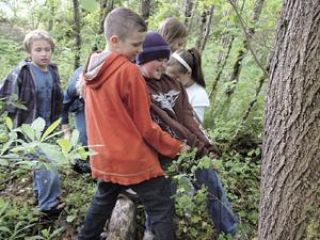By Brenda Sexton-The Courier-Herald
Twice in the past month, Choice Program fourth-grade students have been found pulling invasive ivy off the trees and forest floor behind the Buckley armory.
It's a rescue mission - tied to science.
The students say the ivy on the forest floor blocks sunlight for other plants. They will also tell anyone who wants to listen that the bark of a tree is like its skin and the ivy's tentacles crawl into it. The students say over time the weight of the ivy breaks down the tree's branches, causing the tree to lose its balance, making it susceptible to falling during high winds.
And trees provide oxygen for the planet.
“When we pick the ivy we're making a difference in our environment,” Siara Sanabria said.
“I don't like the feel of pulling it,” Michael Lampkin said. “But it makes me happy to know I'm helping the environment.”
“It takes (ivy) 50 years to kill a tree,” Nathan Lee said. “But it can take out an entire forest.”
The Choice Program is part of the Collins Alternative Programs cooperative between the White River, Sumner, Enumclaw and Orting school districts based in White River. Choice students attend classes with teachers on the Choice campus at Glacier Middle School in Buckley and supplement their education with a parent-supervised curriculum at home.
This isn't the first time Choice Program teacher Raeann Webb's students have spent in the little patch of Buckley woods. In the past, her fourth- fifth- and sixth-grade students, as well as high school environmental science classes, have all spent time yanking out the ivy.
It's a big job. Her students didn't know how big when they decided to tackle the project.
Their first job was to collect data about ivy. They not only walked the forest they would adopt, but wooded areas near their homes or around town.
They discovered there's a lot of ivy out there and ivy growing from people's yards was taking over nearby groves of trees.
In Oregon, they said, ivy is banned and when they collect ivy, they have to keep it sealed in a black trash bag for three months before it dies.
Once the problem was identified they needed a plan of action. The first step was to clean out the existing ivy, which happens during regular work parties. The second is to educate the public about ivy and its destructive ways.
Students are writing letters to the media and talking with other classes. They are designing a flier. They are planning to write to nurseries asking them not to sell it.
Web said through the project her students have developed an understanding of how humans depend on the natural environment and can cause changes in the environment - good or bad - that affect humans' ability to survive.
“I think what's so important is that they feel it,” Webb said. “They learn it and then they feel it.”
The students are already seeing the fruits of their labor. Some of the ivy on the trees is dying, but it's small. Webb said the forest behind the armory will keep her classes busy for years.
“It's fun to come out next year and see that we've saved a tree,” she said.
Brenda Sexton can be reached at bsexton@courierherald.com.


